
Nybrua is a bridge over the Aker River (Akerselva) in Oslo, Norway. [1]

Nybrua is a bridge over the Aker River (Akerselva) in Oslo, Norway. [1]
Nybrua bridge, which was built in 1827, lies in the district of Grünerløkka. It is crossed by Storgata which continues as Trondheimsveien on the eastern side of the river. At the same time, Storgata was lengthened and the lower part of Trondheimsveien was created. [2]
As Oslo's major entrance point from the north, it became a part of Trondhjemske hovedvei which starts at Nybrua and goes to the city limits at Vestli. Later, Vaterland Bridge, as well as Brugata and Lakkegata streets were also added to the route, to the north of the city. Nybrua was later extended and strengthened to take trams and modern motor traffic, although parts of the original structure can still be seen. [3] [4] [5] [6]
Main Article: Nybrua tram stop
Nybrua was served by an Oslo Tramway station of the same name. The station became disused in 2015. [7] Another tram stop nearby (Hausmanns gate) was closed in 2018 and the area was upgraded as part of the Fremtidens Byreise program. A new tram stop called Nybrua was opened on 15th February, 2021. It was established in front of the Legevakten.

Grønland is a neighbourhood in central Oslo, Norway. It is served by several tram and bus lines, as well as the Oslo Metro at the Grønland Station. The neighborhood, along with neighboring Tøyen, is considered to be very ethnically diverse and is home to a large population of immigrants.

Akerselva or Akerselven is a river which flows through Oslo. It starts at Maridalsvannet in Oslomarka, and traverses the boroughs of Nordre Aker, Sagene, Grünerløkka, central Oslo and Grønland, whereby it finally ends at Paulsenkaien and Oset in Bjørvika. The river is considered to be a part of the Nordmarkvassdraget, and has the Norwegian watercourse number 006.Z. The entire river is about 8.2 kilometres (5.1 mi) long, and has a difference in elevation between source and mouth of approximately 149 metres (489 ft).
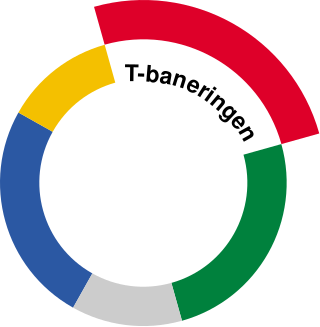
The Ring Line is the newest rapid transit loop line of the Oslo Metro of Oslo, Norway. It connects to the Sognsvann Line in the west and the Grorud Line in the east; along with these two lines and the Common Tunnel, the Ring Line creates a loop serving both the city centre and Nordre Aker borough. The 5.0 kilometres (3.1 mi)-long line has three stations: Nydalen, Storo and Sinsen. Four-fifths of the line runs within two tunnels, with the 1.0-kilometer (0.62 mi) section between Storo and Sinsen, including both stations, being the only at-grade part. The line connects to the Grorud Line north of Carl Berners plass and with the Sognsvann Line north of Ullevål stadion.
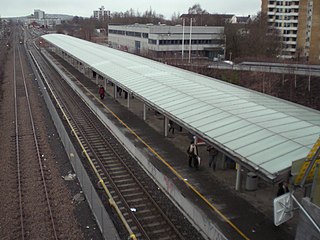
Storo is a rapid transit station on the Ring Line of the Oslo Metro, and a tram station on the Grünerløkka–Torshov Line of the Oslo Tramway. It is located at Storo in the Nordre Aker borough of Oslo, Norway. The tram station opened on 28 November 1902, and the rapid transit station on 20 August 2003. Metro lines 4 and 5 run to the station. The tram station serves lines 11, 12 and 18. The station is within walking distance of Grefsen Station on the Gjøvik Line. The station also functions as a bus hub, being located along Ring 3. Storo is a mixed commercial and residential area, and a shopping center is located just north of the subway station.

AS Sporveisbussene is a bus company that operates about 75% of the routes in Oslo, Norway. The company was created in 1997 when the then Oslo Sporveier was reorganised. It is now a subsidiary of Kollektivtransportproduksjon, a municipal company responsible for operating public transport in Oslo. In 2003 the Oslo City Council decided that bus transport in Oslo was to be based on public service obligation contracts, and Sporveisbussene has steadily lost its routes to these contracts. Instead, Sporveisbussene has established a subsidiary, Nexus Trafikk, that can compete in the competitions, and has won many of them. The company also operates the express coaches branded Lavprisekspressen.
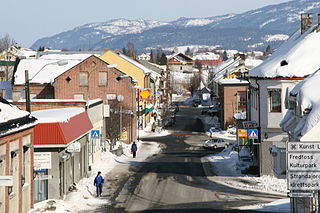
Vestfossen is a village in the municipality of Øvre Eiker in the county of Buskerud, Norway. Vestfossen is a former industrial city with traditions dating back to the 16th century. As of 2008 Vestfossen had a population of 2,867 according to Statistics Norway.

The Sagene Line is a former line of the Oslo Tramway in Norway. It ran from Stortorvet in the city center along Akersgata and Ullevålsveien through the neighborhood of St. Hanshaugen. It then continued along Colletts gate, Geitmyrsveien and Kierschouws gate to Sagene. At Sagene Church it had a regulation stop and access to Sagene Depot. The line continued along Bentsebrugata to Torshov, where it intersected with the Grünerløkka–Torshov Line.
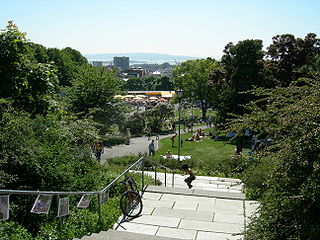
Parks and open spaces are an integral part of the landscape of Oslo, the capital and largest city of Norway. The various parks and open spaces are interconnected by paths so that the city's inhabitants can walk between them.

Nationaltheatret is an underground metro station and tram stop serving Vika and the city center of Oslo, Norway. It is located on the Common Tunnel of the Oslo Metro and on the Briskeby Line of the Oslo Tramway. Also located at the same place is Nationaltheatret Station of the Drammen Line. The station is served by all five lines of the metro, and lines 11 and 13 of the tramway. In addition, several bus services call at the station. It is named for the National Theatre located nearby.
A/S Kristiania Sporveisselskab or KSS, nicknamed the Green Tramway, was an operator of part of the Oslo Tramway from 1875 to 1924. The company was established in 1874 and started with horsecar operations on the Ullevål Hageby Line, Gamlebyen Line and the Grünerløkka–Torshov Line. The network was electrified with in 1899 and 1900, whereby the company was bought by Union-Elektricitäts-Gesellschaft. It delivered new Class U trams. Within a few years the company had also opened the Vålerenga Line and Kampen Line. It took over Kristiania Kommunale Sporveie in 1905, taking over its fleet of Class S trams and the Sagene Ring, the Vippetangen Line and the Rodeløkka Line.

Kristiania Kommunale Sporveie or KKS, colloquially known as the Red Tramway was a municipal owned company that operated parts of the Oslo Tramway from 1899 to 1905. KKS built and operated three lines, Sagene Ring, the Rodeløkka Line and the Vippetangen Line. The three were connected by means of lines of Kristiania Sporveisselskab (KSS) and Kristiania Elektriske Sporvei (KES). KKS bought twenty motorized trams from Schuckert & Co. and twelve trailers, designated as Class S. It built two depots, Sagene and Rodeløkka.
The Grünerløkka–Torshov is a tramway line running between Jernbanetorget to Storo in Oslo, Norway. It is served by lines 11, 12 and 18 of the Oslo Tramway. The line serves the city-centre of Oslo, Grunerlokka and Sagene.

The Sinsen Line is part of the Oslo Tramway on the east side of the city. Most of the line is served by line 17, although the northernmost tip (Grefsen–Torshov) is served by line 18 which otherwise runs on the Grünerløkka–Torshov Line. Both services use SL95 articulated trams.

The history of the Oslo Tramway and Oslo Metro in Oslo, Norway, starts in 1875, when Kristiania Sporveisselskab (KSS) opened two horsecar lines through the city centre. In 1894, Kristiania Elektriske Sporvei (KES) built the first electric street tramways, which ran west from the city centre. Within six years, all tramways were electric. The city council established Kristiania Kommunale Sporveie (KKS) in 1899, which built three lines before it was sold to KSS six years later. Both KSS and KES were taken over by the municipality in 1924, becoming Oslo Sporveier. The company gradually expanded the city tram network, which reached its peak length in 1939.

The Rodeløkka Line is a former line of the Oslo Tramway of Norway. It was in use from 1900 to 1961, serving the neighborhood of Rodeløkka. After closing, the southern part of the line was designated as part of the Sinsen Line. The Rodeløkka Line was built by Kristiania Kommunale Sporveie (KKS) in 1900, and was subsequently taken over by Kristiania Sporveisselskab (KSS) in 1905. In 1924, the ownership was transferred to Oslo Sporveier. It was served by Line 9 until 1949, when it was replaced by a bus service. In 1955, a new route from Carl Berners plass to Rodeløkka was built, and the line was served by Line 13 until 1961, when the service was terminated. The tracks were removed between 1962 and 1964.

Vaterland is a neighborhood in Oslo, Norway. It is located north of the tracks at Oslo Central Station, between Jernbanetorget, Storgata and Akerselva river. The area features Oslo Central Station and Oslo Bus Terminal, the shopping centers Oslo City and Byporten, Galleri Oslo, Radisson Blu Plaza Hotel, the concert arena Oslo Spektrum and Postgirobygget. Along the Aker River lays the Vaterland Park.

Schous plass is a square in the southern part of the borough of Grünerløkka in Oslo, Norway.

Lilletorget is a square in Oslo, Norway. It was established as a square in 1867, and was named Lilletorvet from 1872. It is located near the Vaterland Bridge of Brugata.

Sofienberg Park is a large park in the Grünerløkka district of Oslo, Norway, covering an area of 74 ha.
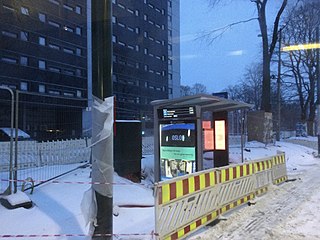
Nybrua is a tram station which was opened in February 2021. It is served by lines 11, 12, 17 and 18. It is located near where the old tram station, Hausmanns gate stood. It is located between Storgata (westbound) and Schous plass and Heimdalsgata. It is served with both SL79 and SL95 trams. SL18 trams also serve the station on routes 17 and 18.
Coordinates: 59°55′4″N10°45′33″E / 59.91778°N 10.75917°E